“I have come to learn that most wildlife, predators included, will avoid conflict at all costs. It’s simply not in their best interest to risk injury or death unless that need is absolutely necessary. Most of the problems that arise due to interactions between people and wildlife are caused by people, not the wildlife.”
– Gary Schroyen
When Mollie Cameron relocated from Ontario to the West Coast of British Columbia (B.C.), she expected that she would encounter the wildlife that lived on Vancouver Island, but she never realized just how close to “home” animals often are. Living in Sooke, Mollie would soon learn she shares her backyard with several species of large carnivores such as wolves, cougars, and bears. After a few jarring encounters, Mollie’s passion for learning more about these animals, and how to peacefully coexist with them, was sparked.
Today, Mollie runs The Cougar Coexistence Initiative, monitoring cougar presence across Vancouver Island and working within her community to help minimize human-wildlife conflict. We sat down with her to learn how one citizen scientist is making a big impact for Vancouver Island’s resident big cats.
Pacific Wild:
Mollie, I’d love to hear about your first encounter with wildlife in B.C.
Mollie Cameron:
I moved here seven years ago and a few weeks into my arrival I had my first very unusual experience with a predator. Coming home from work after dark, I saw a dog run across the street in front of my car. I quickly pulled over and opened my back passenger door to try and get the dog into my car away from the road, and to find its home. The “dog” grabbed a tree with two front paws and stood up on its hind legs and glared at me…at that moment, I realized I was face-to-face with a black bear, not a lost dog! With no prior experience with bears, I was naturally nervous! Something that stuck with me from that encounter was that the animal seemed just as apprehensive as me and was only interested in us parting ways, which we did peacefully.
Pacific Wild:
That must have been an incredible experience. When did you first fall in love with cougars?
Mollie Cameron:
Months after my black bear encounter I would have my first experience with a cougar, late at night and in the dark; this would become a recurring theme in my chance encounters with wildlife.
I was farm-sitting for a friend in Sooke. Unbeknownst to me, at the same time I was doing my nightly inspection, an adult cougar was inspecting the livestock pens, presumably attempting to find an opportunity for an easy meal. I heard a distinct, haunting scream. I didn’t realize what I had encountered until my husband turned the yard light on and saw the cougar running full speed down the driveway before it jumped over the gate. Again, I reveled in this epiphany that despite being so close to the cougar and disturbing its search for food, it feared my presence as much as that scream startled me.
Pacific Wild:
Those sound like revelatory encounters. How did those first-hand experiences change how you understood human-wildlife interactions?
Mollie Cameron:
For most people, that experience could have created a lifelong fear of cougars. For me, it ignited a motivation to understand them that has evolved into a passion to advocate for a better public understanding about how to peacefully coexist on the landscape. My attempt to understand big cats has been a long and slow process. I began by documenting sightings, taking note of interesting behaviors, and identifying areas of repeat cougar activity. When a sighting was posted online I, like so many other budding wildlife enthusiasts, often flew out the door with my camera in hand to try and get a glimpse of the cat. In my early days of cougar admiration, I was naïve enough to think that sighting a cougar this way was a possibility, or a wise idea. Cougars are often referred to as the “ghost cat”. They are rarely seen or heard first-hand by humans. Cougars evolved to blend into their surroundings, and to be almost completely scentless. Due to the thick fur between their paw pads, they have the ability to move through the forest creating very little noise.
Pacific Wild:
You’ve since compiled a substantial amount of data on cougars. How did you go about documenting cougar sightings, given how elusive they can be?
Mollie Cameron:
I continued to document sightings and behavior for almost two years before I met my mentor, Gary Schroyen. Gary and I met by complete chance when we were both attempting to help a friend protect the same 60-acre piece of land a well-used wildlife corridor), from development in the Capital Regional District (CRD). I had already heard Gary’s name a few times and had the impression that he was passionate about predators, just like me. When we met, I spoke of my love of cougars and my desire to understand them better despite the little information available to the public. Just as I was about to leave, Gary said that he was “going to check some trail cameras where I’ve been watching a male and female cougar court each other for the past two weeks…would you like to join me?” Of course, I jumped at the opportunity.
We hiked mountainous terrain for hours, looking at old cougar scat and examining the visual and chemical communication signs that cougars leave behind. We arrived at the first camera, and Gary showed me a video of a male cougar who was missing the end of his tail. I learned that he had been in an altercation with another male cougar, and he was lucky to have made it out alive with only some scars and a stubby tail to tell the tale of what he experienced. Tears filled my eyes as I stood on that mountain feeling immense gratitude to have found someone willing to share such an incredible sight with me. I knew I was in the company of someone who shared the same passion for advocating for a better understanding of these animals. Gary and I have been inseparable friends, studying predators by camera trapping, ever since.
Video credit: Gary Schroyen (westcocanuck@gmail.com)
Pacific Wild:
It sounds like Gary’s mentorship supported your curiosities and aided with your research. How was this relationship foundational to your current work?
Mollie Cameron:
After meeting Gary, my knowledge of cougars expanded immensely and my passion evolved into a project that I now call The Cougar Coexistence Initiative. I began the project by documenting sightings detected by our network of trail cameras and those posted online in community pages. This inspired me to create a map that separates sightings by date, location, and includes information about the sighting, including any information about human-wildlife conflicts. Conflicts include predation on livestock and incidents involving pets or people.
“I have spent over 35,000 hours over the past 15 years hiking solo through areas of south Vancouver Island researching large predators. My goal is to gain a better understanding of these animals, primarily their behaviour, so I can share that knowledge with others through public education. Ultimately, I would like to see that we can eventually learn how to peacefully coexist with them.”
– Gary Schroyen
Pacific Wild:
That’s fascinating. You’ve been very thorough. Can you tell me more about the data collected and what you learned from documenting human-cougar interactions?
Mollie Cameron:
Absolutely. I really want to emphasize that after dedicating so much time to track and understand these animals, I have noticed that cougars make great efforts to avoid humans and conflict with humans; however, they are opportunistic hunters by nature. Cougars do not understand that the majority of humans would prefer that they stay in the forest, out of sight and out of mind, feeding on wild prey species, like deer, available to them on the island. Unsecured livestock, off-leash pets and roaming domestic cats are easy opportunities for cougars to find a meal in their territories that humans have encroached into.
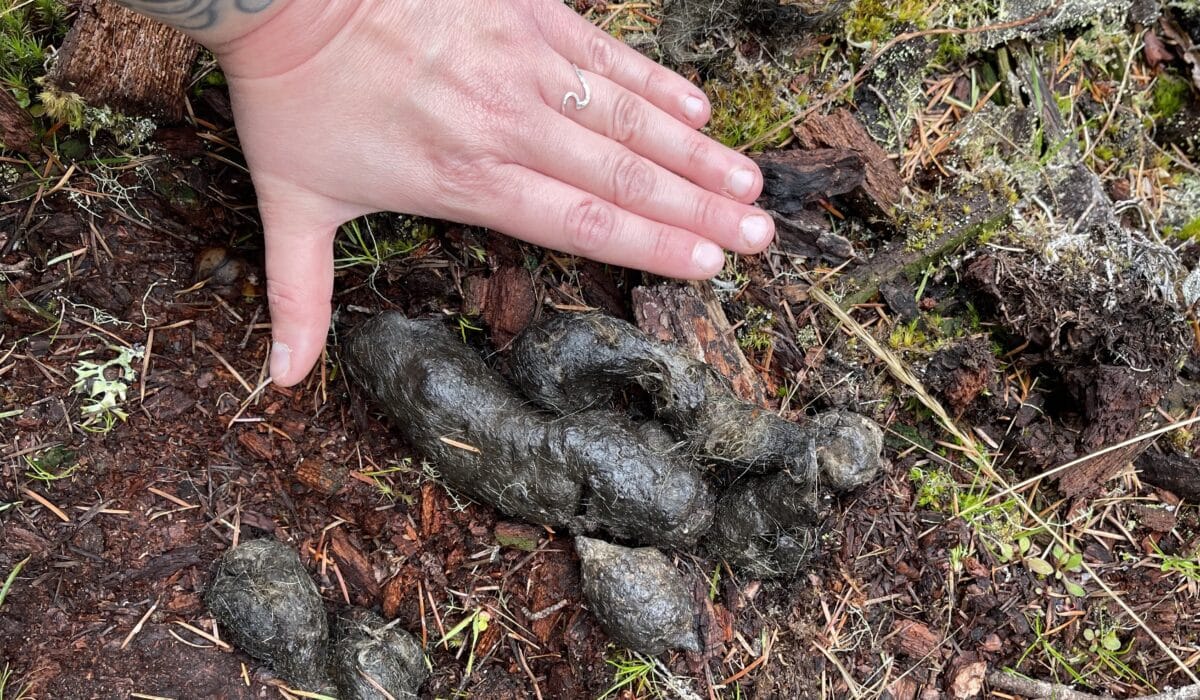
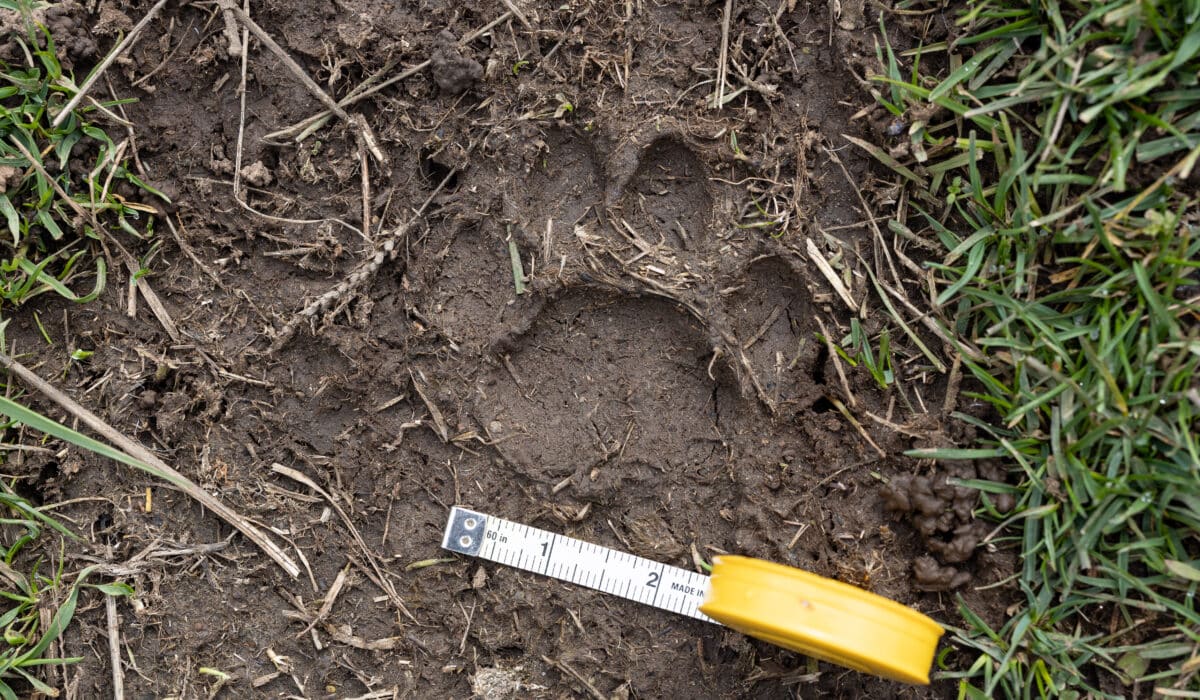
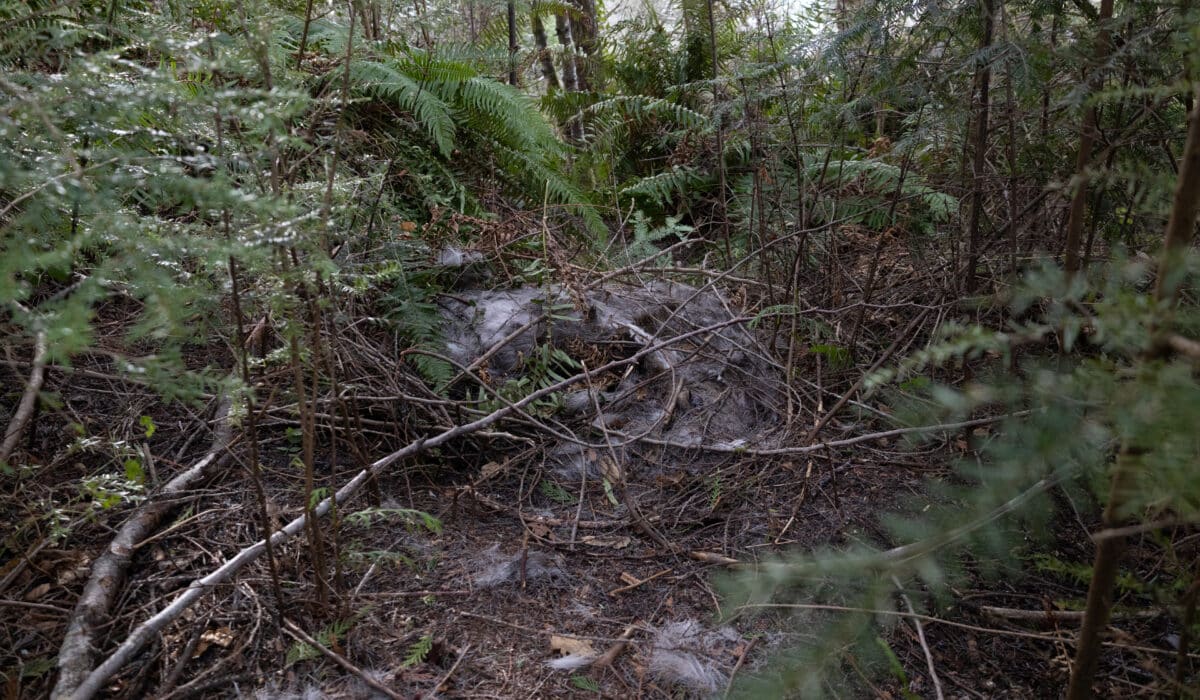
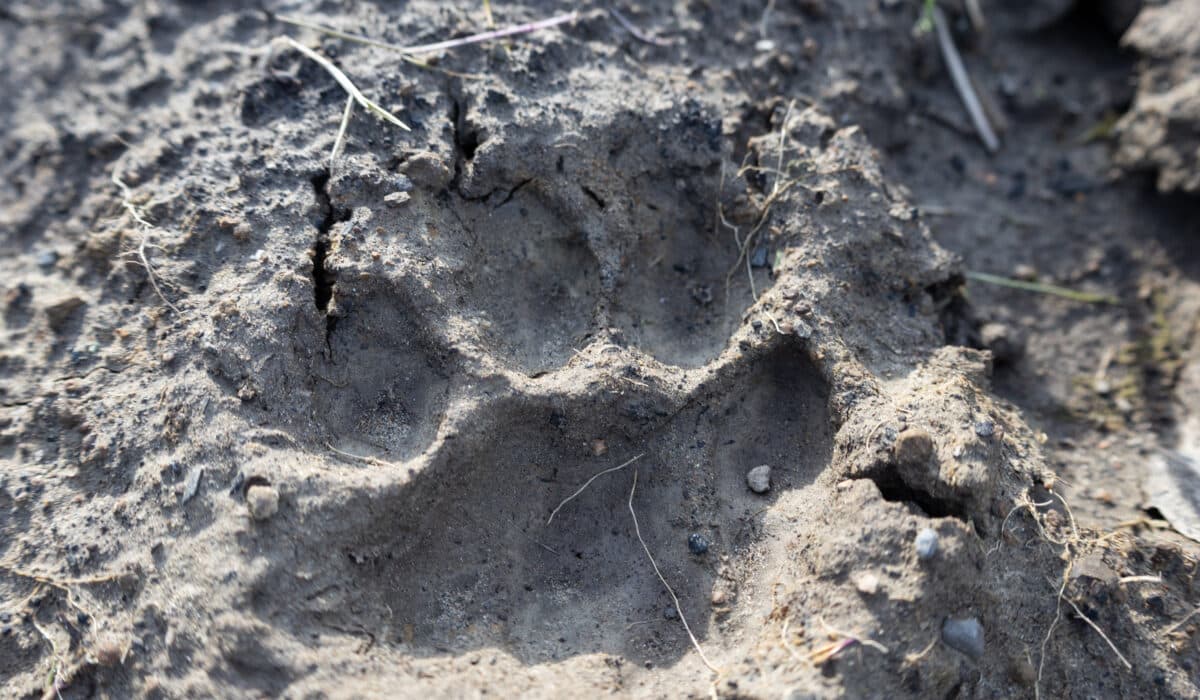
Image credit: Mollie Cameron, @pacificimagery_
Pacific Wild:
It sounds like many of these attractants could be secured, if people chose to do so. Have you connected with people whose properties or livestock are vulnerable to predation?
Mollie Cameron:
I have, yes. After documenting an abundance of conflicts for my maps as second-hand information, I started contacting residents that report conflicts to ask for additional information and data. The majority of the time, people have been incredibly receptive in assisting me and allowing me to come to their property to investigate. Securing attractants is not just a practice to be bear-safe and wolf-wise, but one necessary to peacefully coexist with cougars as well. Some of the most important things I’ve learned from these animals came from documenting predation events on livestock and instances where cats have cached deer carcasses on private land.
As previously mentioned, cougars are opportunistic hunters but they are also incredibly visual animals. In my experience, documenting predation on unsecured livestock often results in several livestock fatalities in one evening but typically only one livestock animal consumed. My observations indicate that once one animal is predated on, the rest in proximity scatter and this may trigger an instinctual predatory response in the cougar to chase.
Pacific Wild:
How would someone go about securing their property?
Mollie Cameron:
Having an enclosure for livestock to go to at night is the best way to keep them safe, as is having properly installed electric fencing as a preliminary deterrent. Poor animal husbandry can often be the cause of predation events, and cougars habituated to predating on livestock are often not candidates for relocation. There is currently no bylaw mandating the securement of livestock to help mitigate conflicts with predators or habituation. This is something I would like to see change in the future.
Pacific Wild:
I’m surprised to learn that there is no mandate in place to minimize conflicts with wildlife and livestock on Vancouver Island. In your opinion, does this amplify the severity of human-wildlife interactions?
Mollie Cameron:
Yes. In my opinion, the implementation of minimum standards for keeping livestock would be a monumental move towards successful coexistence with carnivores. My time spent documenting predation events is educational, albeit challenging, and has shown that livestock predation often results in both predator and prey paying the ultimate price in losing their lives. Additionally, predation of unsecured livestock often is not an isolated incident. Predators, like cougars, are smart. They remember a reliable food source and are likely to keep returning. Return events like this can start off affecting one livestock keeper and go on to affect entire communities of farmers which often results in growing human animosity towards carnivores who, ultimately, were here first.
Pacific Wild:
Why is relocation not always a viable option for habituated predators, like cougars?
Mollie Cameron:
Relocation of habituated predators is seldom a realistic option as livestock predation will often continue elsewhere once the cats have been moved to a new area. Cougars are also extremely territorial animals, and despite the short-tailed male cougar surviving his territory altercation, most aren’t afforded that same success.
Video credit: Mollie Cameron, @pacificimagery_
Pacific Wild:
Do you have recommendations for people looking to secure attractants and minimize encounters with cougars?
Mollie Cameron:
Yes. Collective efforts to keep our own pet and livestock animals safe is one of the most effective ways we can keep predators safe as well and coexist together in a peaceful way. By securing livestock at night, installing electric fencing, and keeping pets on-leash in cougar territory, these big cats are more likely to remain hidden from the human eye.
Pacific Wild:
Those are practical tips. Thank you for sharing. Mollie, you’ve been collecting data on cougars since 2016. Are there any individuals whose stories stand out to you?
Mollie Cameron:
The short-tailed male cougar was given a nickname by Gary. We called him Stumpy. Stumpy was courting a female in the area. We documented them interacting indirectly through the use of olfactory cues several times with the network of trail cameras. After their courtship, Stumpy disappeared and has not been seen since May 2022. The female cougar went on to have four cubs, which is an extremely rare event in the wild. This incredible mother, like most cougar mothers, was hard working, patient and did whatever necessary to provide for her cubs. Cougars are born into natal den sites that provide shelter for cubs against the elements and hide them from dangers lurking in the forest. Mother cougars will often leave their young for hours at a time to hunt. A typical adult cougar may kill an average of one deer-sized prey per week; however, that number will increase with the amount of cubs dependent on her at any given time. Cubs typically nurse exclusively for two months. After that time, mother cougars will start to introduce a carnivorous diet to their young by bringing easily transportable pieces of prey like ribs, jaw bones and limbs back to the natal den. At four months old cubs are often fully weaned and exclusively eating a carnivorous diet.
Pacific Wild:
She sounds like a diligent and hard-working mother. What happened to her and her four cubs?
Mollie Cameron:
The success of a litter the size of Stumpy’s mate was not something Gary and I were optimistic about. Cougar mothers can often only successfully raise two cubs at a time. Larger litters are likely to result in one or more cubs not making it to adolescence as the demand to provide food is too great. In areas where cougar territory overlaps with human settlement, habituated female cougars may resort to preying upon unsecured livestock to support their cubs. Unfortunately, this is what unfolded with the mother of four. This event resulted in a massive livestock loss within the community. It also resulted in the loss of life of the mother cougar as well as her four cubs as they were destroyed by conservation officers.
Pacific Wild: That must have been devastating to learn.
Mollie Cameron:
It definitely was, especially when this was a recurring predation issue over time that could have been addressed with proper livestock management before it came to this unfortunate end. It is important to note that in the 596 documented cougar sightings on Vancouver Island in 2022, only 38 conflicts were reported. These conflicts were exclusive to livestock and off-leash or free roaming pets. In 2022, 7 cougars were destroyed by conservation officers. This number does not include hunting tags fulfilled by those hunters who choose to target predators recreationally.
Video Credit: Gary Schroyen (westcocanuck@gmail.com)
Pacific Wild:
Alongside documenting encounters with cougars, do you have other goals for The Cougar Coexistence Initiative?
Mollie Cameron:
Since being provided an intimate look at so many cougars’ lives through the usage of trail cameras that Gary and I have set up, as well as encountering public posts on social media, I started to notice a distinct uniqueness to individual animals. Some cougars have scarring patterns, some are distinctive by size and others have darker coats. I have not pinpointed a wholly reliable way yet, but I am working towards developing a way to individualize and catalogue cougars in my study area using photo identification. I hope that by accomplishing this, it may help to phase out the use of invasive monitoring methods like tagging or collaring in the future.
Pacific Wild:
That sounds like you’re hoping to give life to the data points on your map – and tell a more well rounded story of cougars in B.C. How else are you hoping to develop your work?
Mollie Cameron:
One of my other goals for this project is to determine well-used wildlife corridors that should be protected from development. With cougars being such territorial animals, dedicated green spaces are essential to their survival. The average lifespan of a cougar is ten years, and it’s not an easy existence for them, especially when living alongside humans. Patrolling and fighting other cats for their claimed territory, only to have humans come in and drastically impact the landscape with new developments adds an extra layer of challenge for cougars living on Vancouver Island. In recent years, humans are seeing more and more cougars. Is it because there are more of them, or is it because the availability of accessible land is changing at an exponential pace? Riparian areas, mountainous ranges and wildlife corridors are necessary for the survival of these animals, and advocating for the protection of their natural habitat is vital.
Prey bones found in cougar den
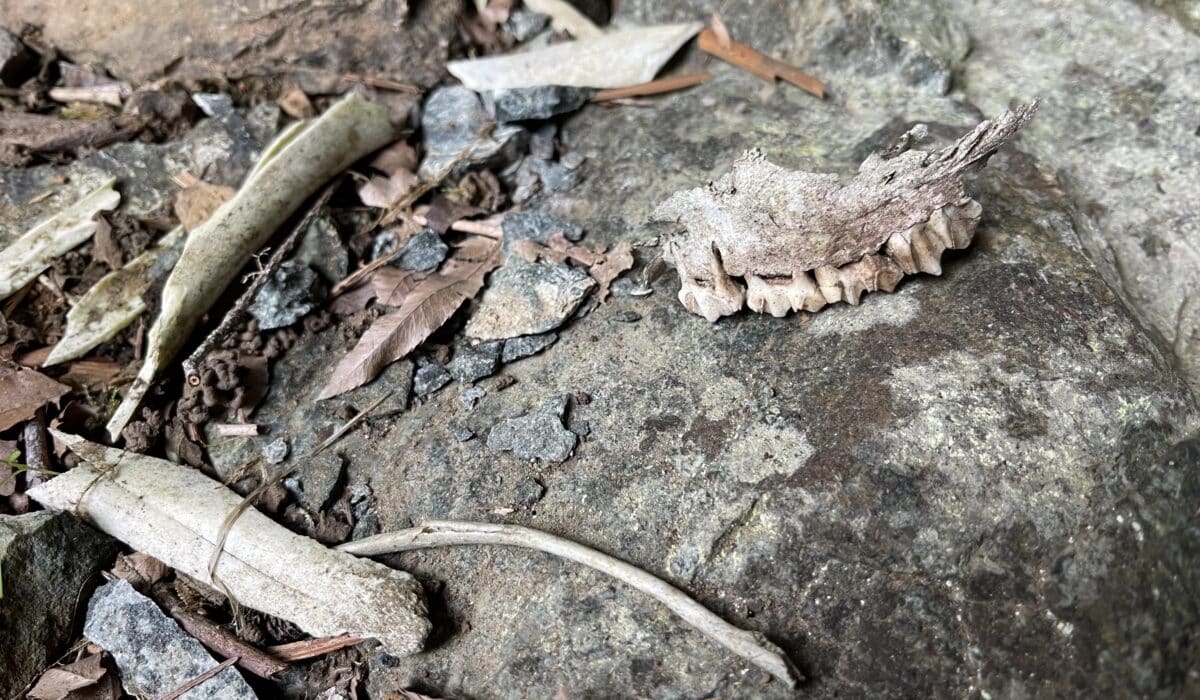
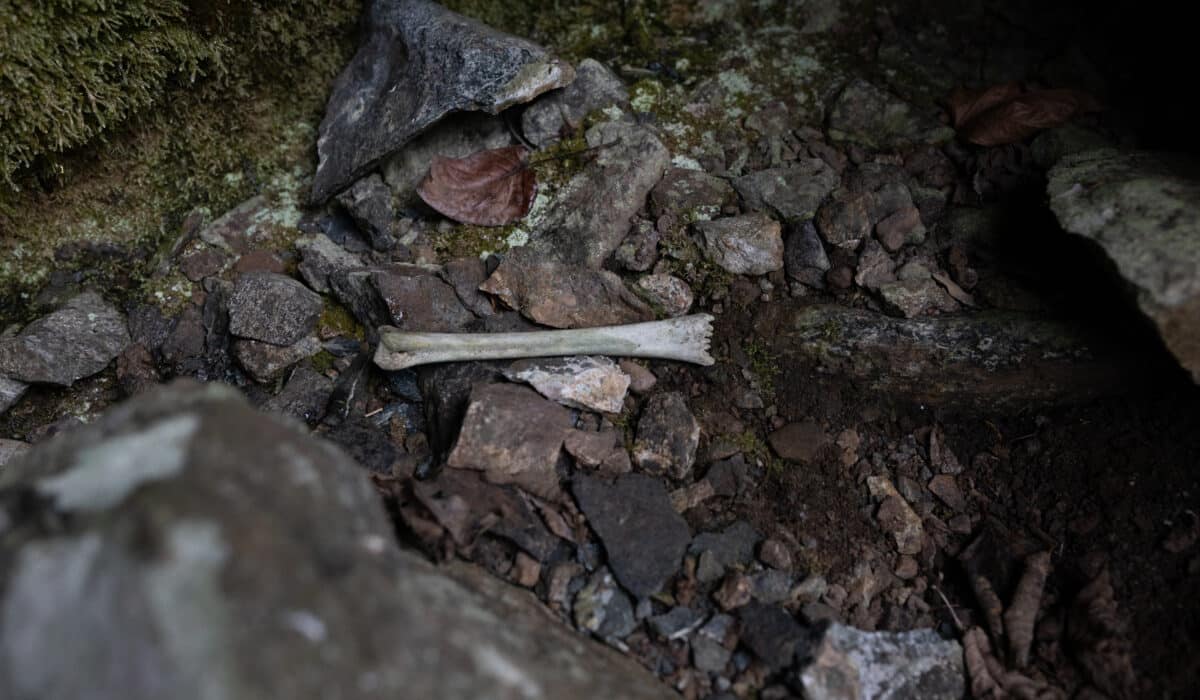
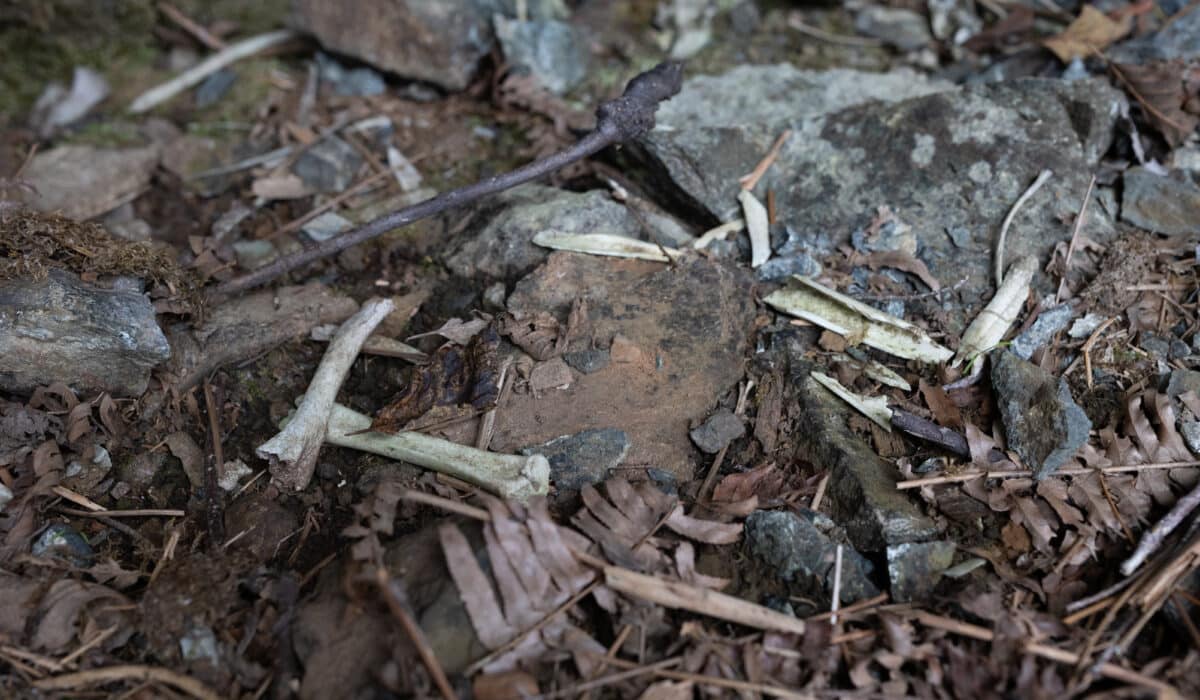
Image credit: Mollie Cameron, @pacificimagery_
Pacific Wild:
Given the many human-initiated threats felt by cougars, how do you hope your research will motivate others to care about human-wildlife interactions?
Mollie Cameron:
Education is the most important part of my mission. I aim to create ways to promote understanding and compassion of cougars rather than fear. With the support of Gary and Wild Wise (an educational society that promotes coexistence) I have been given the resources and platform to provide educational presentations to communities and public schools about predator education, safety, and coexistence. Cougars are truly misunderstood by the public and it is especially disheartening to see the spread of misinformation and fear on social media. As residents of Vancouver Island, we should be prepared to always exist among predators, and not exclusively when our neighbors post a sighting on social media platforms.
“Animals are not to be feared, but understood, and given the due respect that they deserve. I find that so many people have very little true understanding of top apex predators. Much of what most people know of them is what they have read online or seen in the media, which is largely fear based and sensationalized.”
– Gary Schroyen
Pacific Wild:
Thank you for sharing your research and your recommendations. This has been incredibly insightful.
Mollie Cameron:
My pleasure! I consistently advocate that cougars make monumental efforts to avoid human interaction and conflict with humans, so long as we secure our attractants like pets and livestock. After three years of dedicating a portion of time everyday to these animals, documenting kill sites and hiking in well used wildlife corridors, the only encounter I have ever had was that first unexpected moment in the dark of night. Peaceful coexistence is an obtainable and necessary objective for all Canadians living alongside wildlife.
“I believe that the more people understand these animals, the more that they will appreciate and respect them. Only then will people want to help these animals by voicing their support for changing the laws in order to help protect them and foster coexistence. It’s a long road but I’m confident that we are well on our way in that direction.”
– Gary Schroyen
To learn more about the Cougar Coexistence Initiative, contact Mollie Cameron at molliecameron@outlook.com. To inquire about the usage of trail camera footage, please contact Gary Schroyen at westcocanuck@gmail.com

